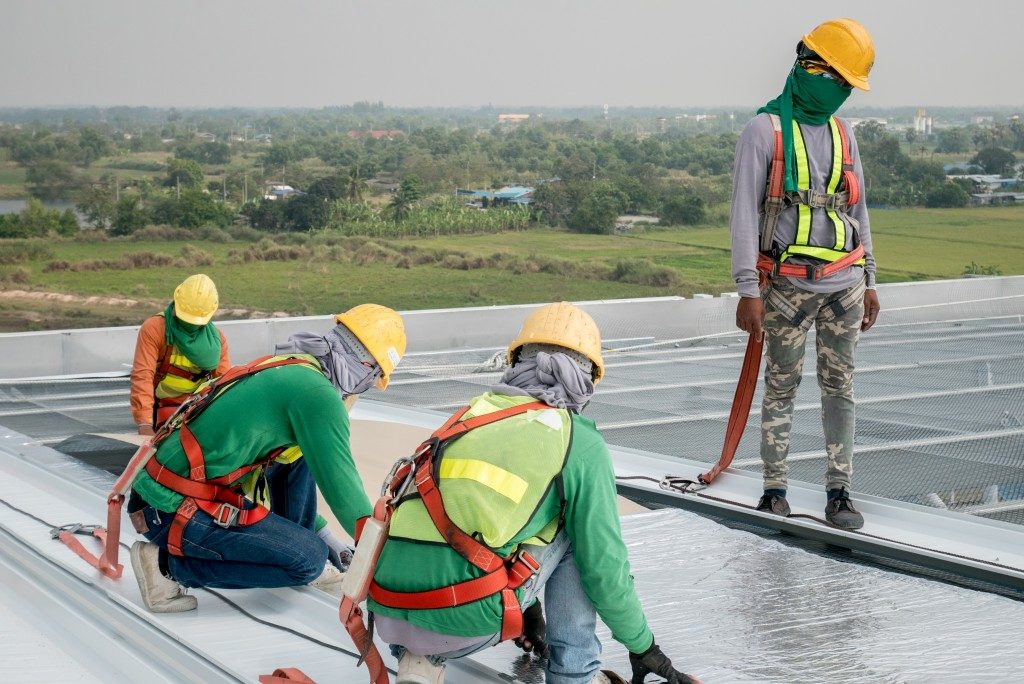When it comes to roofing material maintenance and repair, knowledge is crucial; especially when it comes to roofing material and adhesives.
Single-ply roofing membranes are flat, synthetic polymer-based materials. The membranes are single sheets which are supplied in homogenous or reinforcement-layered sheets and installed in one layer. These roofing membranes are UV-resistant and have greater flexibility compared to other roofing materials. Single-ply roofing panels are also lightweight, impact resistant and accommodate all roofing designs.
There are two categories of single-ply roofing: thermoplastics and thermosets. Thermoplastics include TPO and PVC roofing sheets while thermosets include neoprene, EPDM and CSPE panels. Both roofing membranes are comprised of flashings to protect the roof edges from moisture seepage. They also have an adhesive to bind the panels. Here are the roofing adhesive types used for single-ply roofing membranes.
Single-Part Polyurethane
This is considered the best adhesive option. It can be modified upon its application to different levels to suit your roof. Single-part polyurethane adhesives are applied using spray systems and rollers. They can also be poured onto the roof layer from the container. They are commonly used for flat roofs since they remain durable and robust even in high temperatures once cured. The adhesives, however, require considerable time to cure when used to bind a non-porous surface such as insulation to the single-ply roof.
Two-Part Polyurethanes
These share most of the properties of single-part polyurethane adhesives. They, however, cure more quickly than the latter even through large gaps. They also do not have specific moisture and heat requirements for their curing. As such, their application costs are low. Two-part polyurethane adhesives are flexible and sturdy. Moreover, they will absorb considerable contraction stresses and expansion which other adhesives might not ordinarily withstand.
Solvent-Based Synthetic Rubbers

These are applied onto your roofing membrane’s back and substrate in two coats using brushes, sprayers or rollers. The layer is then pressed to the substrate to consolidate the membrane and substrate. Solvent-based synthetic rubber adhesives have an instant bond. Diligence is nonetheless vital since the substrate should be dry as any moisture leads to the formation of solvent blisters between the roofing panel and substrate. Excessive dryness of the substrate, on the other hand, makes it impossible for the substrate to adhere to the roofing membrane properly. Solvent-based synthetic adhesives are also applied in temperatures not exceeding 50 degrees Celsius.
Water-Based Acrylics
These are single-component adhesives which can be roller-applied or brushed onto your substrate. Water-based acrylics are not however used for on-site adherence of roofing membranes. This is because the adhesives will not dry in temperatures below 1000 degrees Celsius. They are nonetheless an excellent choice for factory-adhered single-ply roofing membranes since they have exceptional bond strength.
Regardless of the adhesive used on your property’s single-ply roof, proper surface preparation is crucial to guarantee the single-ply roofing panel and substrate form a strong bond. Remember that the strength of your bond largely depends on the roofing layer you choose. To this end, ensure you pick the best supplier you can for your single-ply roofing panels regardless of cost. Most roofing suppliers also stock the above adhesives, and it is prudent to get both the roof and adhesive from the same store.

